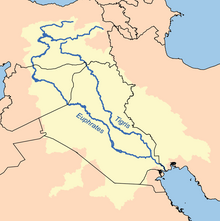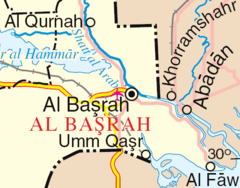Iran–Iraq border
The Iran-Iraq boundary runs for 1,458 kilometers, from the Shatt al-Arab waterway to the tripoint boundary with modern Turkey at the Kuh e-Dalanper. Although the boundary was first determined in 1639, certain disputes fester, particularly disputes surrounding navigation on the Shatt al-Arab waterway. The currently binding treaty, the Algiers Agreement (1975) [1] has been in force since signed by both nations in 1975 and ratified by both nations in 1976.
Boundary line

The boundary begins in the Persian Gulf at the "lowest point of low water" at the mouth of the Shatt al-Arab at 29° 51' 16" N and 48° 44' 45" E (WGS84.) It then closely following the thalweg of the Shatt al-Arab for some 105 kilometers in a series of short straight line segments, reaching the confluence of the Shatt al-Arab and the Nahr al-Khayin tributary. From there it winds northward, following a series of boundary markers across plain and hill, through the Zagros Mountains Nahr at-Tib, and Nahr Wadi. It meets the boundary with Turkey at 37° 08' 44" N and 44° 47' 05" E.
History
The boundary dates back to the 1639 Zohab Treaty between the Ottoman Empire, which controlled Iraq, and Persia. The agreement stipulated that the boundary would run between the Zagros Mountains and the Tigris River. In 1724, the Ottomans rejected the boundary-line and invaded Persia, but when peace was finally concluded in 1746, the two states recognized the 1639 boundary as official. This was affirmed by the 1847 Treaty of Erzerum, however, the new treaty first raised the issue of the Shatt al-Arab waterway. The boundary was set at the eastern bank of the Persian gulf, so that the entire waterway remained under Turkish (i.e., Iraqi) control. In the following years, the boundary-line was further delineated, and a detailed map was produced in 1860.

A more precise demarcation was begun in 1911 at the urging of Russia and Great Britain, both of whom had colonial aspirations in the region. In 1913-1914, a commission established by the Constantinople Protocol set the revised boundary, with control of the Shatt al-Arab going to Turkey. In general, the line was to follow the east bank of the waterway, except in the region surrounding the Persian town of Khorramshahr, where it was to follow the thalweg.
This was challenged by Iran in 1934, as the validity of both the Treaty of Erzerum and the Constantinople Protocol was called into question. The dispute was resolved in 1937, following the general lines of the old boundary, with the exception of the area immediately around the Iranian town of Abadan, where the boundary was moved from the east bank to the thalweg, as had been done around Khorramshahr two decades earlier.
While this resolved Iran's major grievances, it failed to respond to the issue of freedom of navigation in the Shatt al-Arab. This was resolved in 1975, when Iran and Iraq signed an agreement in Algiers in which the thalweg was determined to be the boundary throughout the Shatt al-Arab waterway. In return, Iran promised to cease its support for Kurdish rebels in northern Iraq. The new treaty was rejected by Iraq five years later, and was a cause of the Iran-Iraq war. Iraq finally accepted the new boundary in 1990 following its failed invasion of Kuwait, in accordance with United Nations Resolution 598.
Today
Although Iraq accepted Resolution 598, it continues to question the validity of the Algiers Agreement (1975) regarding its boundary with Iran. Under international law, a bilateral or multilateral treaty cannot be abrogated by one party and one party only, and thus various statements to that effect about this agreement have had no legal effect. In 2004 and again in March, 2007, the boundary question rose to international prominence when Iranian soldiers seized British sailors operating in the vicinity of the Shatt al-Arab, in what Iran alleged were its own territorial waters.
Source
Biger, Gideon. The Encyclopedia of International Boundaries, Facts on File, 1995. ISBN 0816032335
Notes
- ^ "'UN Treaty Series Vol. 1017 full text of treaty'". United Nations. 1985.
{{cite news}}: Check date values in:|date=(help)
